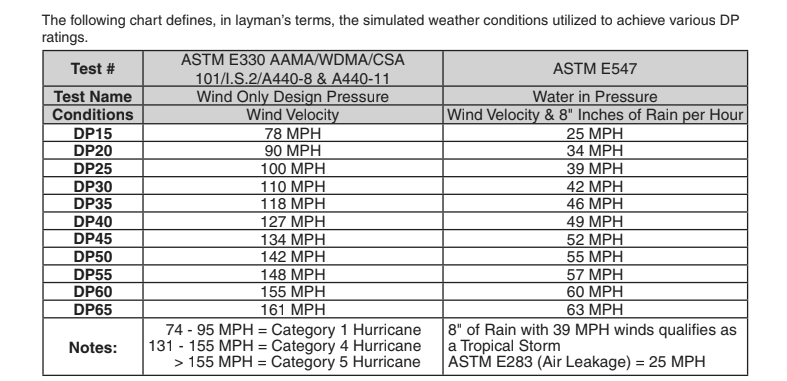One crucial aspect that you shouldn’t overlook is Design Pressure Ratings.
As we mentioned in our last post, some contractors use big or confusing words to try and justify extra costs. Others, like the experts at Jim Oliviers, genuinely want to be helpful and sometimes forget homeowners don’t share their common knowledge. That being said, let’s get to decoding.
What is DP Rating?
Design Pressure testing originated in the 1940s. It was created by a group of window manufacturers and engineers concerned about the impact of severe weather systems, such as hurricanes. The main goal of DP Rating is to measure how well building products, specifically windows and doors, can withstand different types of storms. These tests evaluate wind loads to determine the resistance of windows in severe weather conditions.
In order to meet national building codes, including the International Building Code (IBC), International Residential Code (IRC), and Housing and Urban Development (HUD) standards, windows and doors must undergo testing and certification. These standards require windows and sliding glass doors to pass air, water, and structural testing. On the other hand, side-hinged doors typically only need to undergo air and structural testing. While these code requirements are primarily enforced in coastal states like those along the Atlantic and Gulf coasts—specifically Louisiana—it’s essential for all homeowners to ensure their windows meet the standards.
Why is DP Rating Important?
When it comes to structural testing, DP Ratings are crucial for assessing the wind load resistance of door systems. DP Ratings are established at various levels, with higher ratings indicating greater resistance to wind pressure. For example, a DP-20 rating replicates a 90 MPH wind, while a DP-50 rating simulates 141 MPH wind. These ratings provide homeowners with valuable information about how well their windows and doors can withstand severe weather conditions.
Water resistance testing is another important aspect to consider when evaluating windows. This test assesses a window’s ability to resist water penetration under various conditions. The test is conducted with and without air pressure, with the pass/fail test referred to as DP-0. In the absence of air pressure, water falls on the exterior of the window without any added wind force. If no water penetrates the interior of the window, the test is considered a pass. Water pressure tests are conducted at different wind speeds, with DP-20 tests simulating 8 inches of rain per hour in 34 MPH winds, and DP-50 tests replicating the same rain volume in 55 MPH winds.

According to USA.com, Louisiana has the highest average annual rainfall in the nation (59.15 inches), it’s clear that water resistance testing is crucial for ensuring that your windows can withstand heavy rain and storms. By selecting windows with high DP Rating, you can rest assured that your home will be well-protected against severe weather conditions.
When shopping for new windows, don’t let home contractors intimidate you. Learn more from our Jim Olivier blog so you can decode the lingo, and inquire about key factors like the Design Pressure Ratings. Choosing windows and doors with high DP Ratings will not only ensure safety and durability but also provide you with peace of mind during severe weather events.
When it comes to upgrading your windows, don’t overlook the importance of DP Rating – just another factor in helping you love your home again.
[/fsn_text][/fsn_column][/fsn_row]




